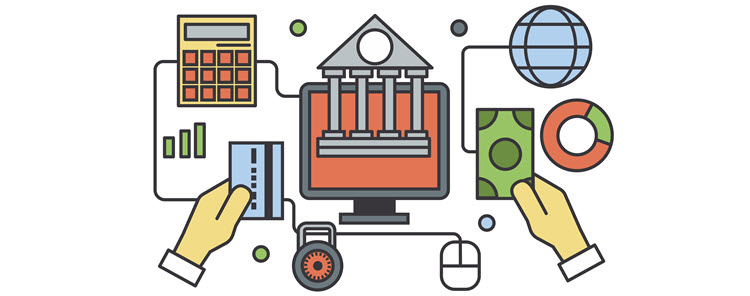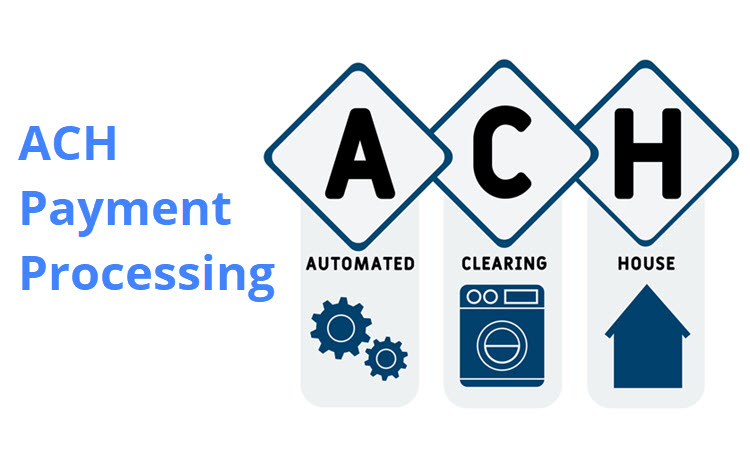Electronic payments are the foundation of the modern economy. The speedy and reliable electronic transfer of money between banks rests on the work of established payment clearing networks and governing bodies.
In the United States, the network that facilitates electronic payments is the Automated Clearing House (ACH), and its governing body is the National Automated Clearing House Association (Nacha).
Find out what ACH payments are, what ACH payment processing entails, and what it takes to make and accept ACH payments.
What is ACH Payment Processing?
ACH payment processing refers to electronic transactions made from one U.S. bank account to another. ACH payments are an alternative to credit and debit cards, wire transfers, and paper checks.
ACH payments go through the Automated Clearing House (ACH) network. The ACH was established in the 1970s as an alternative to check payments. The network is developed and governed by Nacha, the National Automated Clearing House Association.
Note: ACH payments are a type of electronic funds transfer (EFT), meaning no physical money exchanges hands. However, EFT is an umbrella term that includes other payment methods. For further clarification, refer to our article ACH vs. EFT: Everything You Need to Know.
ACH Payment Types
The ACH network recognizes and processes two types of transactions – direct deposits, and direct payments.
Direct Deposit
Direct deposits are electronic money transfers from a business or government entity to an individual. They typically include:
- Employee paychecks
- Employee reimbursements
- Government benefits
- Tax refunds
- Annuities
- Interest payments
A variation of the direct deposit is the split deposit, which involves transferring funds from the payer to two separate accounts of the recipient, for example, a checking and savings account.
Direct Payment
An ACH direct payment is used by individuals, businesses, or other organizations to transfer money. Examples of direct payments are:
- Peer-to-peer payments (via apps such as Zelle and Venmo)
- Utility bill payments
- Mortgage payments
- Subscriptions, etc.
An ACH direct payment is used by individuals, businesses, or other organizations to transfer money. Examples of direct payments are:
- ACH debits. With this type of electronic funds transfer a payee requests (“pulls”) funds from the payer. Prior to this, the payer must provide payment authorization so that the recipient has permission to pull the funds. An example of an ACH debit is when a utility company automatically removes funds from an individual’s account every month.
- ACH credits. With this type of transaction, the payer initiates the request by “pushing” the funds to the recipient’s account. An example of this kind of payment is when a business pays its outstanding invoices to another company.
ACH Payments Features
ACH payments are characterized by the following features:
- ACH deposits are processed and settled in three time frames. The ACH network offers “same-day”, “next-day”, and “2-day” payment options.
- Both deposits and payments are settled on workdays. Deposits that fall on a weekend or holiday are settled on the prior Friday. Payments are collected on the next business day.
- ACH does not incur fees to transaction participants. Only the financial institutions processing ACH payments pay administrative fees to Nacha.
- ACH cannot process paychecks. Even if a paycheck is deposited electronically via remote deposit, it is not processed by instant payment systems such as ACH.
- The ACH network processes payments 23¼ hours every business day. Payments are also settled four times a day.
How Does ACH Payment Processing Work?

The ACH payment flow differs slightly based on whether the transaction is a deposit or payment.
ACH Direct Deposit – Payment Flow
- The payee provides payment and bank account information to the payer.
- The payer forwards the transaction data to the originating depository financial institution (ODFI).
- The ODFI sorts and forwards the transaction data and funds to the ACH operator.
- The ACH operator forwards the transaction data and funds to the correct receiving depository financial institution (RDFI).
- The RDFI settles the transaction by depositing the funds to the payee’s bank account.
ACH Direct Payment – Payment Flow
- The payer grants the payee authorization to pull funds from their account and provides the transaction data.
- The payee requests the payment and forwards the transaction data to the originating depository financial institution (ODFI).
- The ODFI sorts and forwards the transaction data to the ACH operator.
- ACH operator distributes the transaction data to the correct receiving depository financial institution (RDFI).
- The RDFI forwards the transaction data to the payer’s bank account and pulls the funds.
For more on the participants in ACH payments, consult our article ODFI vs. RDFI: Definitions and Differences.
How to Make ACH Payments
To make an ACH payment the payer has to provide the payee with their account details and with authorization to “pull” funds.
Authorization can be provided via:
- Paper form
- Phone call
- Online form
As long as the amount and frequency of the payments remains the same, the receiving party can continue to pull funds. No changes to the payments can be made without informing the payer beforehand.
How to Accept ACH Payments

To accept ACH payments, businesses must partner with a reliable payment processor that will guide them through the process of opening a merchant account.
Receiving an ACH payment from customers begins with providing the relevant data and documents to the business’s payment processor. This includes:
- The client’s bank account and routing number
- The amount of the payment
- The date of the payment and information on whether it is a one-time or recurring payment
- Authorization from the customer
Note: For detailed information on how merchants can receive ACH payments, what the associated costs and processing times are, refer to our article How to Accept ACH Payments.
Advantages and Disadvantages of ACH Payments

Before deciding whether to offer ACH transfers as a payment option, merchants must get acquainted with their advantages and disadvantages.
Advantages
- Cost-efficiency. ACH transfers are free, unlike wire transfers that incur a $10-$30 fee per domestic transfers.
- Ability to repeat. ACH transfers can be set to repeat, which is ideal for subscription businesses.
- Convenience. Once a repeating ACH transfer is set up, customers do not have to worry about it anymore until they are ready to cancel.
- High retention. Customers may not notice when their credit or debit card expires, leading to involuntary churn. ACH transfers occur from one bank account to another, so no credit or debit cards are involved. This eliminates one of the causes of churn and increases customer retention.
- Availability. Anyone with a bank account in the U.S. can use ACH transfers.
Disadvantages
- Speed. ACH transfers are not instant. Even same-day transfers are not guaranteed to clear the same day.
- Fraud risk. Transaction participants can go a couple of days without knowing whether their transaction has cleared. This leaves room for fraud, which is why banks force transaction limits.
- Caps. ACH transfers are subject to transfer limits. Limits can be daily, monthly, or per transaction, and range from $2,000 to $25,000. Wire transfers are a better option for larger amounts of money.
- U.S.-only. ACH transfers only work between U.S. banks. To send money internationally, merchants and individuals must set up an international bank transfer through their bank or a third-party transfer service provider.
Note: The European equivalent of ACH is SEPA. Planning on expanding into the European market? Find out What Are SEPA Payments and How Do They Work?.
ACH Payment Processing FAQs

Here you will find answers to some of the frequently asked questions regarding ACH payment processing.
Which Businesses Need ACH Payment Processing?
Whether or not a business should make and accept ACH payments depends on its needs.
ACH payments suit businesses that operate within the United States and:
- Offer online orders
- Offer subscriptions
- Make repeat orders from a supplier or supply another business themselves
- Offer mail and telephone orders (MOTO)
- Have multiple accounts for internal funds
Do All Banks Use ACH?
All banks in the U.S. can use ACH to some extent as the minimum requirement is a U.S.-based bank account. In addition to banks, ACH payments are provided by popular payment processors.
Do Banks Charge for ACH?
Some banks offer ACH transfers for free to businesses and individuals. Those that do not, typically charge the following rates:
| Type of Fee | Cost |
|---|---|
| Flat fee/transaction | $0.20 - $1.50 |
| Percentage fee/transaction | 0.5% - 1.5% |
| Monthly fee | $5 - $30 |
| Return fee/return | $2 - $5 |
| Reversal (chargeback) fee/instance | $5 - $25 |
ACH vs. eChecks
Both ACH transfers and eChecks are processed through the ACH network, however, there are distinct differences between the two payment instruments.
ACH transfers are U.S.-only, clear in 2-3 business days, and are typically free. Meanwhile, eChecks have no territorial limitations, clear in 2-5 banking days, and incur transfer fees.
Note: For more details on how these two payment instruments compare, refer to our guide eCheck vs. ACH: Definitions, Similarities, and Differences.
ACH vs. Wire Transfers
The advantage of wire transfers over ACH transfers is that they have no territorial limitations and clear and deposit within 48 hours. However, every wire transfer incurs a $10-$30 fee for domestic transfers, and even higher fees for international transfers, making it a lot more expensive than ACH.
Note: For more details, check out our detailed ACH vs. Wire Transfer Comparison.
ACH vs. Credit Cards
When customers wish to pay for an online order, the checkout process is a little different for ACH and credit cards.
Customers using their credit card can complete the payment without going through an additional approval process. Any other person who has access to the same card could use it to pay for an order with no issues.
For ACH to be enabled as a payment option, a customer has to first request ACH to be available to them, and then pass a verification check.
Note: Read more in-depth about the differences between ACH and credit cards.
ACH vs. Direct Deposit
A direct deposit is one form of ACH transfers. Because of this, direct deposit and ACH are used interchangeably.
However, ACH refers not only to direct deposits, but to a wider range of services, including:
- Converting paper checks to electronic transfers.
- Electronically deducting funds for orders made via web, mail, or phone.
- Converting paper checks to electronic images using a mobile banking application.
Conclusion
You now know what ACH payments are, what the payment flow looks like, and what it takes to make and accept ACH payments.
Use the information in this guide to determine whether making and accepting ACH payments suits the needs of your business.
